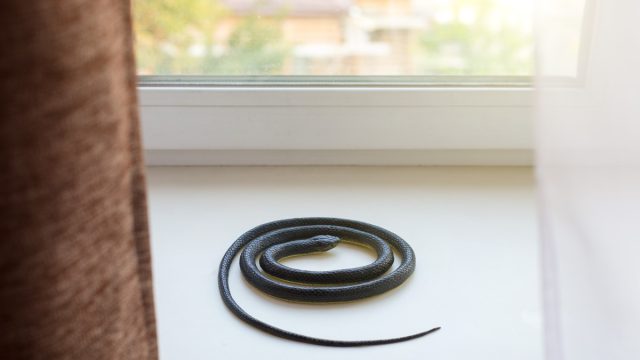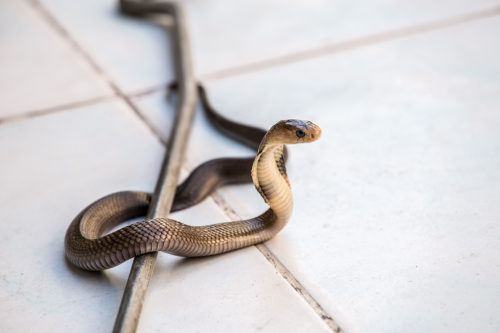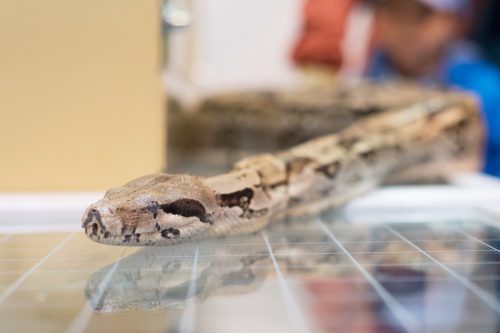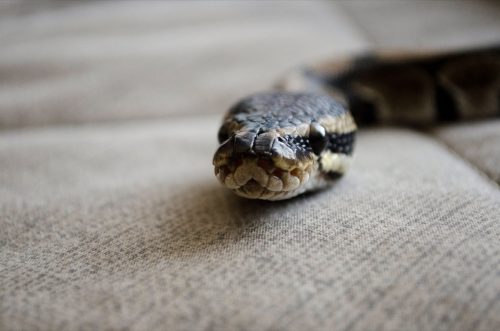If You See a Snake in Your Home, Do This Immediately, CDC Says

Snakes aren’t exactly a welcome sight in most people’s homes. Unfortunately, that doesn’t stop them from sneakily slithering their way into our space. One of the biggest problems with at-home snake encounters is that we generally don’t know they’re there until we stumble on them suddenly, as snakes tend to hide out of sight. But while coming face to face with an unexpected danger is sure to startle anyone, the Centers for Disease Control and Prevention (CDC) has important guidance on how exactly you should act when you see a snake in your home, and panicking is not part of the advice. Read on to find out what the agency says you should do in the event of this reptile encounter.
READ THIS NEXT: 6 Reasons Snakes Come in Your House, Experts Say.
Thousands of people in the U.S. are bitten by venomous snakes annually.

Workers found 45 snakes hiding in a Texas home in 2019. A California woman discovered 90 snakes hibernating under her house in 2021. Snake encounters can be extremely overwhelming, but it’s far less likely you’ll have to deal with that many at once. Nevertheless, even one snake can be dangerous. Christoph Mans, DACZM, an exotic animal specialist at the University of Wisconsin-Madison’s Veterinary Care Hospital, told the Arizona Daily Star there are about 50 different snake species in the U.S. and some of them are indeed venomous.
In the U.S., an estimated 7,000 to 8,000 people are bitten by a venomous snake every year, and about five of those people die as a result of their bite, according to the CDC. To prevent this outcome, the agency has provided guidance on what to do when you come across one of these potentially deadly creatures in your home.
The CDC says you should do one thing immediately to prevent a snake bite.

The CDC advises homeowners to “be cautious” that snakes may seek shelter in their home, especially in certain situations—like after a natural disaster when animals could be displaced from their natural habitats. But what should you do to prevent being bitten if you do run into one? It’s simple: “If you see a snake, back away from it slowly and do not touch it,” the CDC says.
According to the agency, the average American should never try to deal with a snake themselves—even if it’s already in their home. Picking up the snake yourself or trying to trap it “may put you or someone else at risk for a bite,” the CDC explains. Instead, the agency advises homeowners to back away first and then call the animal control agency in their county.
RELATED: For more up-to-date information, sign up for our daily newsletter.
Experts warn that snakes can be quick to attack.

The simplest hesitation when seeing a snake in your home could put you in danger. A.H. David, a snake expert and founder of PestControlWeekly.com, tells Best Life that some snakes can “react as quickly as seconds,” leaving people no chance to escape from the snake’s bite if they don’t back away immediately. According to David, it’s best to try and keep at least 5 to 6 feet of distance from any snake.
“Some snakes are very aggressive—when they see any movement towards them, they feel that they are in danger and they quickly respond in the form of an attack on you,” he explains. “So it’s highly advisable that back your feet slowly from a snake with utmost care.”
You should make sure to keep track of where the snake is in your home.

According to Charles van Rees, PhD, a conservation scientist and founder of the Gulo in Nature blog, your local county or city wildlife office will likely be able to help you identify if the snake in your home is venomous or not. If it is, “they will send someone to retrieve it,” he says. You should also make sure to keep track of the last time and place you saw the snake in your home in case you lose sight of it while waiting for someone to come remove it.
“Report that info to the professional when they arrive,” van Rees advises. “It’s best not to go hunting for the snake and risk a close encounter unless you are absolutely sure it’s a non-venomous species.”
As for non-venomous snakes, you may be given specific directions from your local county or city wildlife office for removing the pest yourself, the conservation scientist notes. If you are responsible for getting a snake out of your space, you should still avoid going near it. Instead, van Rees says that the best approach would be providing an exit option for the snake. “Nearby doors or windows should remain open if possible,” he says. “I would not recommend trying to barricade the snake or block it off from moving around; not only might this mean getting close to the snake, but many snakes are adept at passing through small spaces, so it’s hard to actually make a barrier that they can’t pass.”